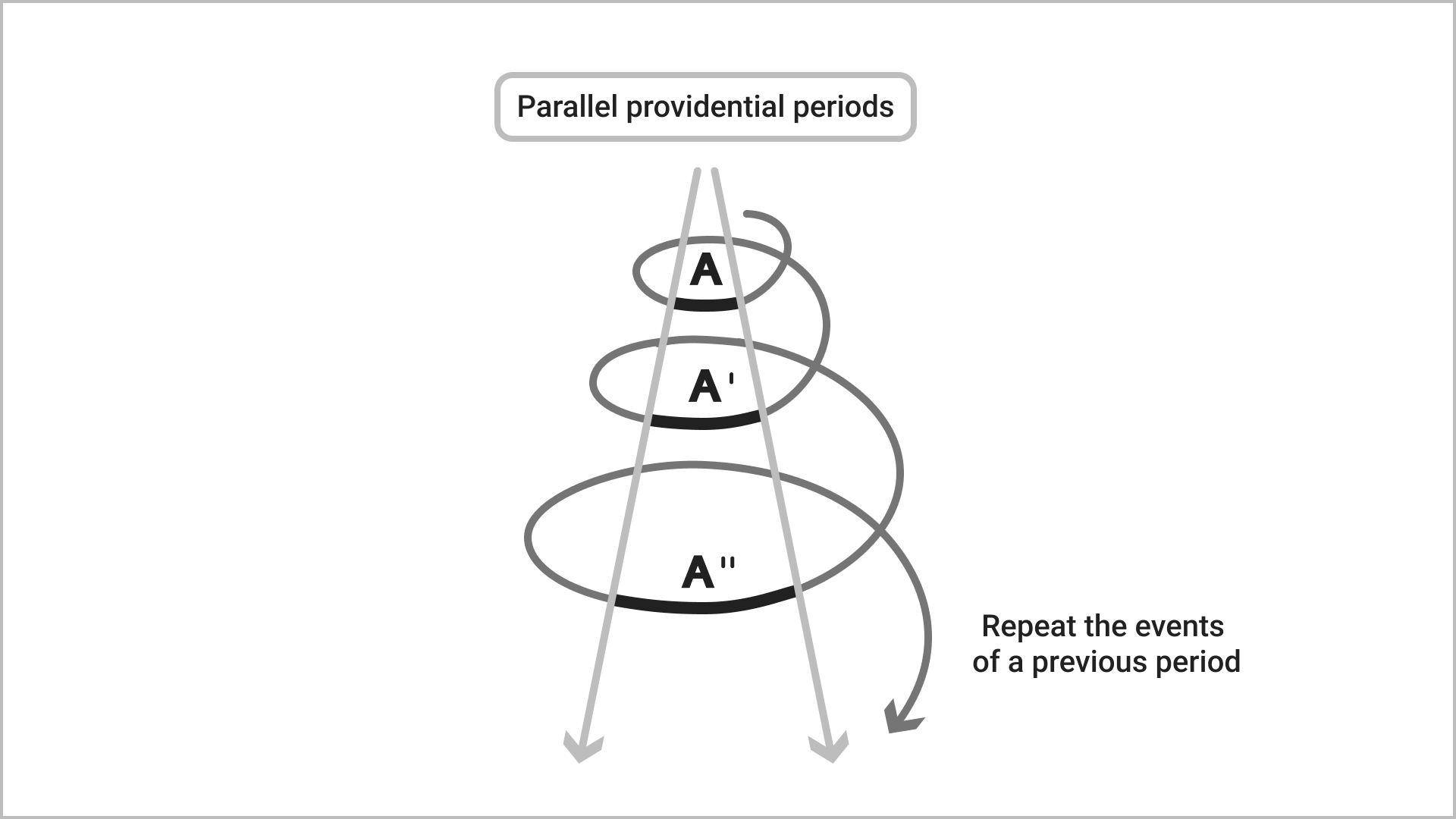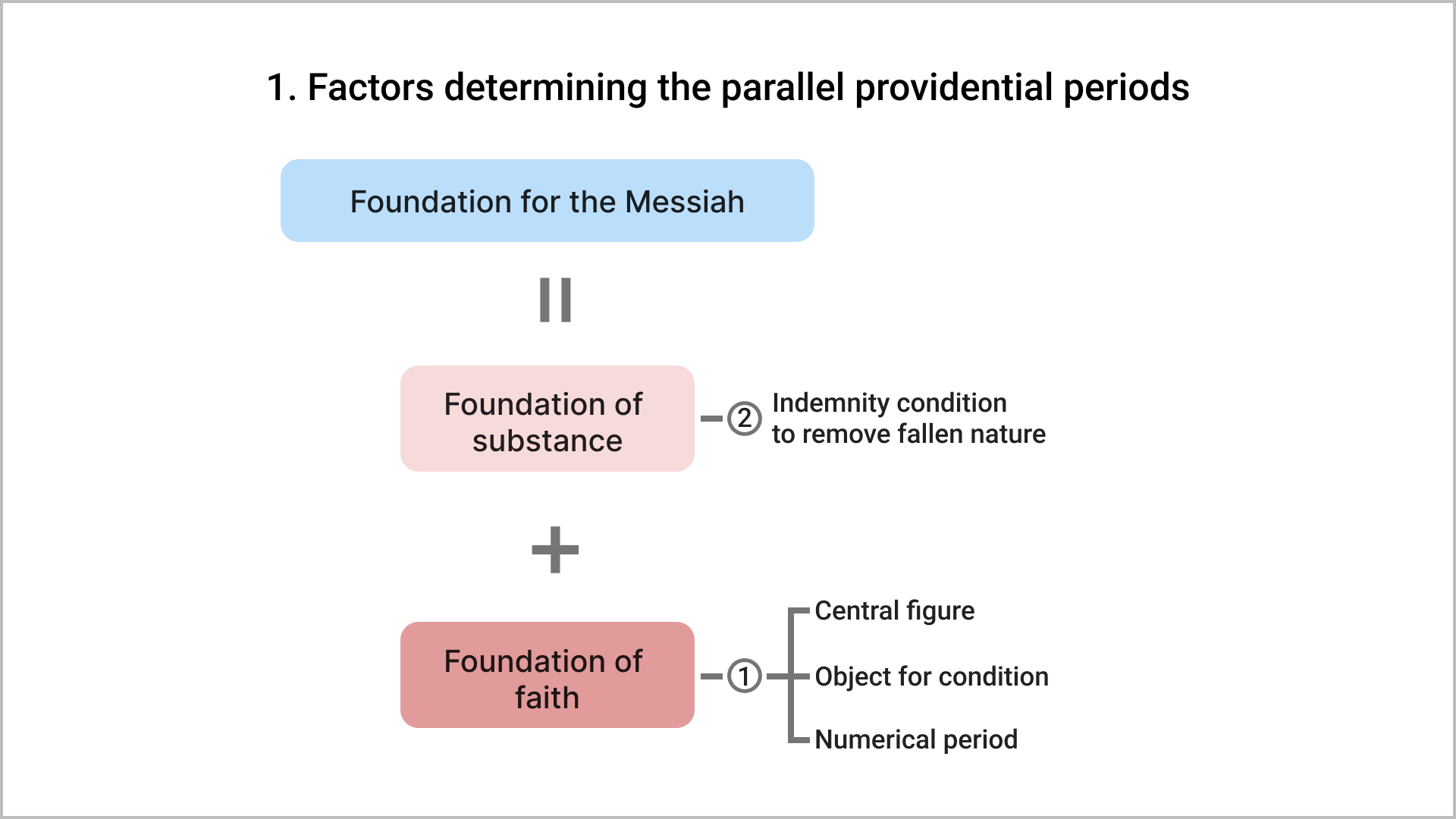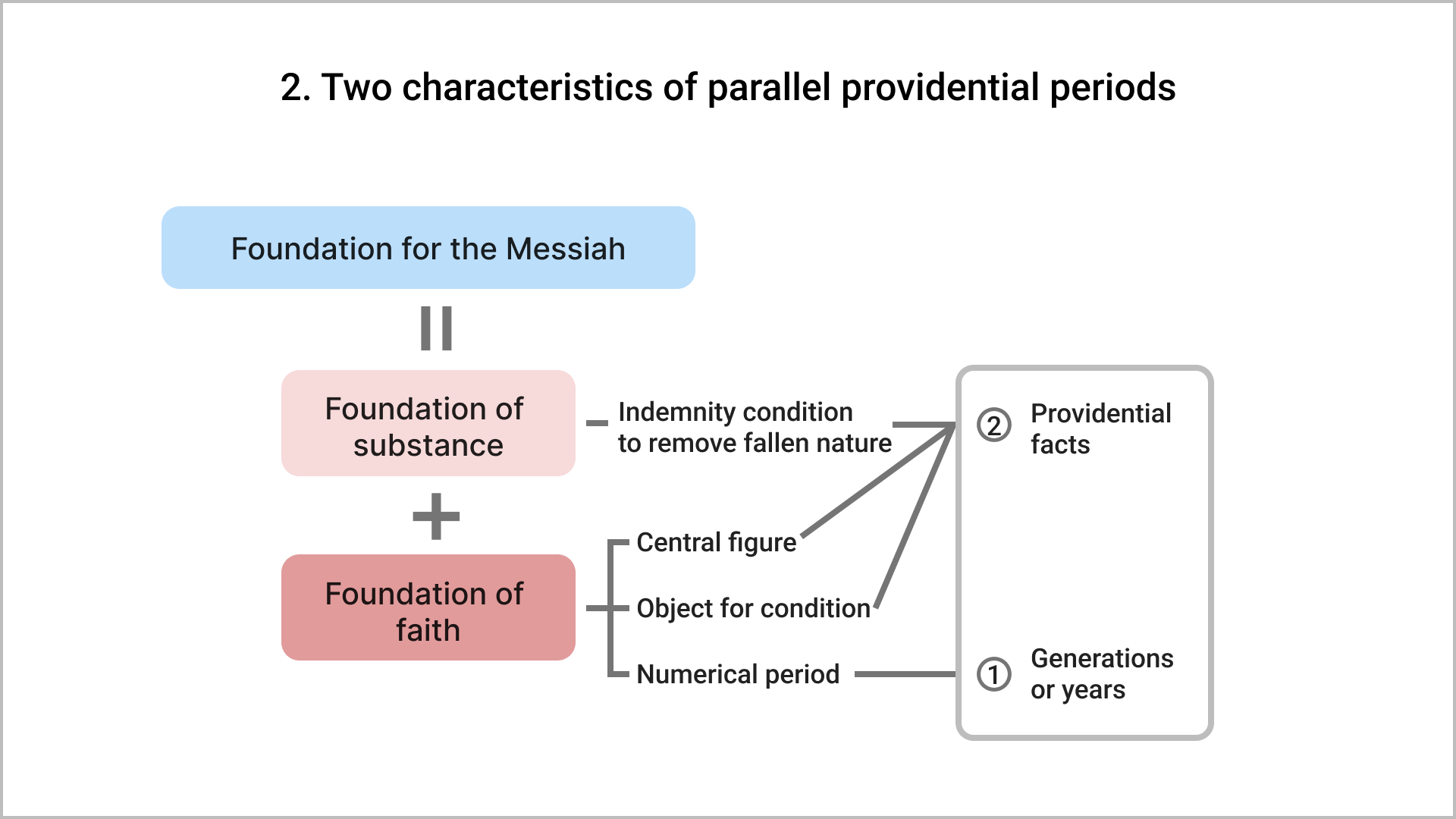동시성(同時性)의 시대(時代)란 무엇인가? 인류역사의 과정을 살 펴보면 비록 그 정도와 범위의 차이는 있지만, 지나간 어느 시대에 있었던 것과 흡사한 형의 역사적 과정이 뒷시대에 반복되고 있는 사실을 많이 발견할 수 있다. 사가(史家)들은 이러한 역사적인 현상을 보고 역사노정(歷史路程)은 어떠한 동형(同型)의 나선상(螺線上)을 돌고 있다고 말하고 있지만, 그 원인이 어디에 있는지를 전혀 알지 못하고 있다. 이와 같이 어떤 시대가 그 전시대(前時代)의 역사노정과 흡사한 모습으로 반복되는 경우, 그러한 시대들을 말하여 ‘섭리적 동시성의 시대’라고 하는 것이다. 그리고 이러한 동시성의 시대를 일러 섭리적 동시성의 시대라고 하는 이유에 대해서는 아래에서 더욱 자세히 설명하겠거니와, 이 현상이 본래 하나님의 탕감복귀섭리(蕩減復歸攝理)에 기인(基因)하고 있기 때문이다.
Examining the course of human history, we often find cases where the various circumstances of a period in history are repeated in similar form during a later age. Some historians are impressed by these phenomena and point out that history progresses in a spiral movement. Yet they do not understand the underlying cause. When a period of history repeats the events of a previous period, albeit with differences in scope and degree, the two periods are called parallel providential periods. As will be explained below, the reason for using this terminology is because the principal cause behind these parallels lies in God’s providence of restoration.

그러면 섭리적 동시성의 시대는 어찌하여 생기게 되는가? 우리는 복귀섭리(復歸攝理)의 목적 을 이루어 나오는 과정에서 되어진 모든 사실들이 역사를 형성해 나왔다는 것을 잘 알고 있다. 그런데 복귀섭리의 목적을 이루 기 위하여 ‘메시아를 위한 기대’를 복귀하는 섭리노정을 걸어가던 어떠한 중심인물(中心人物)이 자기의 책임분담(責任分擔) 을 다하지 못할 때에는, 그 인물을 중심한 섭리의 한 시대는 끝나고 만다. 그러나 그 ‘뜻’에 대한 하나님의 예정(豫定)은 절 대적이기 때문에(전편 제6장), 하나님은 다른 인물을 그의 대신으로 세워 ‘메시아를 위한 기대’를 탕감복귀(蕩減復歸)하는 새 시대를 다시 세워 나아가시는 것이다. 따라서 이 새 시대는 전시대의 역사노정을 탕감복귀하는 시대가 되기 때문에, 다시 한 번 똑같은 노정의 역사를 반복하게 되어 섭리적인 동시성의 시대는 형성되는 것이다.
How do parallel providential periods come about? The course of history has been shaped by various events in the providence of restoration, which drives history toward a fixed goal. When a central figure in the providence fails his responsibility to restore the foundation for the Messiah, the providential period centering on that person comes to a close. Yet, since God has predestined the absolute and eventual fulfillment of His Will, (cf. Predestination 1) He chooses another person to carry on the mission and opens another historical period in the providence to restore through indemnity the foundation for the Messiah. Since this new period restores through indemnity the previous period, a course with similar events will be repeated. This is how the periods come to be parallel to one another.
그런데 복귀섭리(復歸攝理)를 담당한 인물들은 그 전 시대의 종적인 탕감조건(蕩減條 件)들을 횡적으로 일시에 탕감복귀해야 되므로, 복귀섭리가 연장되어 종적인 탕감조건이 부가되어 갈수록 횡적으로 세워야 할 탕감조건도 점차로 가중되어 가는 것이다. 따라서 동시성의 시대도 점차로 그 내용과 범위를 달리하게 된다. 동시성의 시대의 형태가 완전한 상사형(相似形)을 이루지 못하는 이유는 여기에 있는 것이다.
However, parallel periods do not have exactly the same form and content, because the central figure in a particular period must restore in his time (horizontally) the unfulfilled indemnity conditions of the previous periods (vertically). The more the providence of restoration is prolonged and past indemnity conditions accumulate, the heavier will be the conditions of indemnity which the new central figure must fulfill. Consequently, the new parallel period will differ from the previous parallel period in content and scale.
한편 성장기간(成長期間)의 3단계를 그 형으로써 분류해 본다면 소생(蘇 生)은 상징형(象徵型), 장성(長成)은 형상형(形象型), 그리고 완성(完成)은 실체형(實體型)으로 나누어지게 되므로, 복귀섭리 노정(復歸攝理路程)에서 이러한 형들을 동시성으로 반복해 온 시대들도 역시 그러한 형의 역사를 재현시켜 나왔던 것이다. 즉 복귀섭리역사의 전기간을 형으로 본 동시성의 관점에서 갈라 본다면, 복귀기대섭리시 대(復歸基臺攝理時代)는 상징적 동시성의 시대요, 복귀섭리시대(復歸攝理時代)는 형상적 동시성의 시대이며, 복귀섭리연장시대 (復歸攝理延長時代)는 실체적 동시성의 시대인 것이다.
The three stages of the growing period may be classified according to different degrees of manifestation: the formation stage is a manifestation in symbol, the growth stage in image, and the completion stage in substance. Likewise, in the development of history, the parallel periods in the providence of restoration have repeated similar events according to this pattern. Thus, the entire history of the providence of restoration may be divided according to the form of the parallels: the Age of the Providence to Lay the Foundation for Restoration is the age of symbolic parallels, the Age of the Providence of Restoration is the age of image parallels, and the Age of the Prolongation of the Providence of Restoration is the age of substantial parallels.
Next, let us examine the main factors which determine the formation of parallel providential periods.
이처럼 동시성의 시대가 반복되는 이유는 ‘메시아를 위한 기대’를 복귀 하려는 섭리가 반복되기 때문이다. 따라서 동시성의 시대를 형성하는 요인으로, 첫째는 ‘믿음의 기대’를 복귀하기 위한 세 가 지의 조건을 들 수 있는 것이니, 그것은 이 기대를 위한 중심인물(中心人物)과 조건물(條件物)과 수리적(數理的)인 기간(期間) 등이다. 그리고 그 둘째는 ‘실체기대(實體基臺)’를 복귀하기 위한 ‘타락성을 벗기 위한 탕감조건’이다.
Parallel providential periods recur because of repeated dispensations to restore the foundation for the Messiah. Accordingly, the factors which determine the formation of parallel providential periods are: first, the three conditions necessary for the foundation of faith (the central figure, the object for the condition and the numerical period of indemnity) and second, the indemnity condition to remove the fallen nature, which is necessary to restore the foundation of substance.

Based on these factors, two characteristics of parallel providential periods stand out.
그 첫째는 ‘믿음의 기대’를 복귀하기 위한 수리적 탕감기간(蕩減期間)인 대수(代數) 나 혹은 연수(年數)를 요인으로 하여 섭리적 동시성이 형성되는 것이다.
First, the lengths of the parallel providential periods are determined based on a fixed number of generations or years of the indemnity period necessary for restoring the foundation of faith.
복귀섭리역사(復歸攝理歷史)는 그 섭리를 담당한 중심인물들이 책임분담( 責任分擔)을 다하지 못함으로써 그 뜻이 연장됨에 따라 상실되었던 ‘믿음의 기대’를 끝내 반복하여 탕감복귀해 나오신 섭리 역사(攝理歷史)였던 것이다. 그리하여 여기에서 필연적으로 수리적인 ‘믿음의 기간’을 탕감복귀하는 섭리도 반복하게 됨으 로써, 결국 섭리적 동시성의 시대는 어떠한 연수나 혹은 대수의 반복에 의하여 동일한 형을 거듭 형성해 나온 것이었다. 본장의 목적은 바로 이에 관한 문제를 다루려는 데 있다.
In the providence of restoration, when a central figure has failed to complete his responsibility and caused the prolongation of the Will, God repeats His work through other central figures until the final restoration of the lost foundation of faith is achieved. In each dispensation, the numerical period of indemnity for restoring this foundation must be repeated in some form. For this reason, the parallel periods in history have similar lengths, each representing the same fixed number of years or generations. The purpose of this chapter is to discuss this matter in detail.
둘째로는 ‘믿음의 기대’를 복귀하는 중심인물과 그 조건물, 그리고 ‘실체기대’를 복귀하기 위한 ‘타락성을 벗기 위한 탕감조건’ 등의 섭리적인 사실을 요인으로 하여 동시성이 형성되는 것이다.
Second, the parallels in history are shaped by the other three providential factors: the central figure and the object for the condition offered for the foundation of faith, and the indemnity condition to remove the fallen nature for the foundation of substance.

복귀섭리(復歸攝理)의 목적은 결국 ‘메시아를 위한 기대’를 복귀하려는 데 있으므로, 그 섭리가 연장됨에 따라 이 기대를 복귀하려는 섭리도 반복된다. 그런데 ‘메시아를 위한 기대’는 먼저 ‘상징 헌제(象徵獻祭)’로써 ‘믿음의 기대’를 복귀하고 다음에 ‘실체헌제(實體獻祭)’로써 ‘실체기대(實體基臺)’를 복귀해야만 비로소 그것이 세워지는 것이다. 따라서 복귀섭리의 역사는 ‘상징헌제’와 ‘실체헌제’를 복귀하려는 섭리를 반복하여 왔기 때문에, 섭리적 동시성의 시대는 결국 이 두 헌제를 복귀하려 했던 섭리적인 사실을 중심하고 형성되는 것이다. 이에 관한 문제는 다음 장에서 상론(詳論)하기로 하겠다.
The goal of the providence of restoration is ultimately to restore the foundation for the Messiah. Accordingly, when the providence is prolonged, the various dispensations involved in restoring this foundation are also repeated. Since the foundation for the Messiah can be established only by first laying the foundation of faith through the symbolic offering and then laying the foundation of substance through the substantial offering, providential history has been repeating dispensations to restore these two offerings. These dispensations have shaped the parallels between providential periods. We will elaborate on this matter in the next chapter.